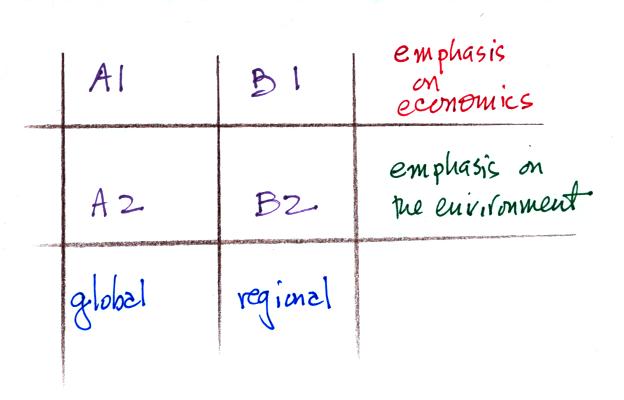
The Emissions Scenarios of the Special Report on Emissions Scenarios (SRES)

The Emissions scenarios can be divided into 4 categories as
shown in the figure above. Groups A and B differ according to
whether there is a move toward globalization (Group A) or whether
regionals differences are maintained (Group B). For Group 1 the
main consideration is economic development during the next
century. In the case of Group 2 more consideration is given to
the environment and sustainable growth. The descriptions of
the 4 main groups and subgroups from the "Summary
for Policymakers" in Climate Change 2001: The Scientific
Basis, , Intergovernmental Panel on Climate Change (available at www.ipcc.ch/reports/tar/wg1/index.htm
) are included below.
A1.
The A1 scenario family describes a future world of very
rapid economic growth, global population that peaks in mid-century and
declines thereafter, and the rapid introduction of new and more
efficient technologies. Major underlying themes are convergence among
regions, capacity building and increased cultural and social
interactions, with a substantial reduction in regional differences in
per capita income. The A1 scenario family develops into three groups
that describe alternative directions of technological change in the
energy system. The three A1 groups are distinguished by their
technological emphasis: fossil intensive (A1FI), non-fossil energy
sources (A1T), or a balance across all sources (A1B) (where balanced is
defined as not relying too heavily on one particular energy source, on
the assumption that similar improvement rates apply to all energy
supply and end use technologies).
A2.
The A2 storyline and scenario family describes a very heterogeneous
world. The underlying theme is self-reliance and preservation of local
identities. Fertility patterns across regions converge very slowly,
which results in continuously increasing population. Economic
development is primarily regionally oriented and per capita economic
growth and technological change more fragmented and slower than other
storylines.
B1.
The B1 storyline and scenario family describes a convergent world with
the same global population, that peaks in mid-century and declines
thereafter, as in the A1 storyline, but with rapid change in economic
structures toward a service and information economy, with reductions in
material intensity and the introduction of clean and resource-efficient
technologies. The emphasis is on global solutions to economic, social
and environmental sustainability, including improved equity, but
without additional climate initiatives.
B2.
The B2 storyline and scenario family describes a world in which the
emphasis is on local solutions to economic, social and environmental
sustainability. It is a world with continuously increasing global
population, at a rate lower than A2, intermediate levels of economic
development, and less rapid and more diverse technological change than
in the B1 and A1 storylines. While the scenario is also oriented
towards environmental protection and social equity, it focuses on local
and regional levels.
An illustrative scenario was chosen for each of the six scenario groups A1B, A1FI, A1T, A2, B1 and B2. All should be considered equally sound.
The SRES scenarios do not include additional climate
initiatives, which means that no scenarios are included that explicitly
assume implementation of the United Nations Framework Convention on
Climate Change or the emissions targets of the Kyoto Protocol.
Figures and scenario descriptions are from: "Summary
for Policymakers" in Climate Change 2001: The Scientific
Basis, , Intergovernmental Panel on Climate Change (available at www.ipcc.ch/reports/tar/wg1/index.htm
)